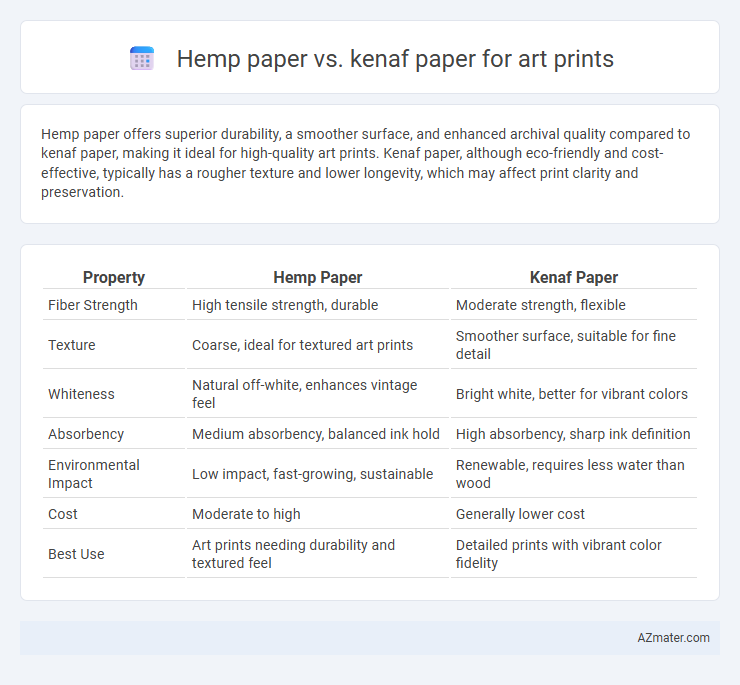Hemp paper offers superior durability, a smoother surface, and enhanced archival quality compared to kenaf paper, making it ideal for high-quality art prints. Kenaf paper, although eco-friendly and cost-effective, typically has a rougher texture and lower longevity, which may affect print clarity and preservation.
Table of Comparison
| Property | Hemp Paper | Kenaf Paper |
|---|---|---|
| Fiber Strength | High tensile strength, durable | Moderate strength, flexible |
| Texture | Coarse, ideal for textured art prints | Smoother surface, suitable for fine detail |
| Whiteness | Natural off-white, enhances vintage feel | Bright white, better for vibrant colors |
| Absorbency | Medium absorbency, balanced ink hold | High absorbency, sharp ink definition |
| Environmental Impact | Low impact, fast-growing, sustainable | Renewable, requires less water than wood |
| Cost | Moderate to high | Generally lower cost |
| Best Use | Art prints needing durability and textured feel | Detailed prints with vibrant color fidelity |
Introduction to Hemp Paper and Kenaf Paper
Hemp paper, derived from the fibers of the Cannabis sativa plant, offers exceptional durability, a smooth texture, and eco-friendly qualities due to its rapid growth and minimal pesticide requirements. Kenaf paper, made from the core fibers of Hibiscus cannabinus, is prized for its brightness, fine grain, and sustainable cultivation that reduces deforestation. Both hemp and kenaf papers provide superior alternatives to traditional wood pulp papers, with unique fiber properties ideal for high-quality art print applications demanding longevity and clarity.
Historical Uses of Hemp and Kenaf in Papermaking
Hemp paper has been historically valued for its strong fibers and durability, dating back to ancient China where it was extensively used for manuscripts and official documents. Kenaf paper, derived from the kenaf plant native to Africa and Asia, gained prominence in the 20th century as a sustainable alternative with high cellulose content suitable for art prints. Both materials offer unique textures and archival qualities, with hemp's long fibers providing resistance to aging and kenaf's versatile fiber structure enabling smooth printing surfaces.
Sustainable Sourcing and Environmental Impact
Hemp paper offers a more sustainable sourcing option due to its fast growth cycle of 3-4 months and minimal pesticide requirements, significantly reducing environmental impact compared to traditional wood paper. Kenaf paper, derived from the hibiscus plant, also supports sustainability with a rapid growth rate of around 4-5 months and high yield per acre, promoting efficient land use and lower carbon footprint. Both papers provide eco-friendly alternatives for art prints, but hemp's higher fiber strength and durability often result in superior print quality and longer-lasting artwork.
Fiber Characteristics: Hemp vs Kenaf
Hemp paper offers longer, stronger fibers averaging 2-5 mm, resulting in durable, high-quality art prints with excellent texture and ink retention. Kenaf fibers, typically 1-3 mm in length, produce smoother but less robust paper, making them suitable for detailed prints requiring a fine surface finish. The higher lignin content in kenaf can affect paper acidity, whereas hemp's low lignin fiber leads to more archival, acid-free prints ideal for long-lasting artwork.
Texture and Surface Qualities for Art Prints
Hemp paper offers a smooth yet fibrous texture with excellent durability, creating a unique tactile feel ideal for high-quality art prints. Kenaf paper features a finer grain and softer surface, providing sharper image reproduction and vibrant color retention for detailed artworks. Both papers excel in archival quality, but hemp's natural roughness contrasts with kenaf's silky finish, influencing the overall aesthetic and print longevity.
Ink Absorption and Color Reproduction
Hemp paper offers superior ink absorption due to its natural fiber structure, resulting in vibrant and sharp color reproduction ideal for high-quality art prints. Kenaf paper has a smoother surface that provides moderate ink absorption but may cause slight color diffusion, affecting the crispness of detailed artwork. For artists prioritizing vivid and accurate color output, hemp paper typically outperforms kenaf paper in maintaining the integrity of printed images.
Durability and Longevity of Prints
Hemp paper offers superior durability and longevity for art prints due to its high cellulose content and resistance to yellowing, ensuring vibrant colors remain intact over decades. Kenaf paper also provides strong fibers but tends to be less resistant to environmental factors like moisture and UV exposure, which can degrade print quality more rapidly. For archival art prints, hemp paper is preferred for maintaining structural integrity and colorfastness over time.
Cost and Availability Comparison
Hemp paper typically costs more due to higher processing expenses but offers superior durability and environmental benefits, making it a preferred choice for premium art prints. Kenaf paper is generally more affordable and widely available because of its faster growth cycle and abundant supply, which reduces material costs for large-scale art print production. Artists and printers seeking a balance between cost-efficiency and sustainable quality often choose Kenaf for budget-conscious projects, while hemp remains favored for high-end, archival-quality prints.
Artist and Printer Preferences
Artists and printers often prefer hemp paper for art prints due to its superior durability, smooth texture, and excellent ink retention, which enhances color vibrancy and detail reproduction. Kenaf paper, while eco-friendly and moderately durable, typically exhibits a coarser texture that may affect fine line precision and subtle gradient effects favored in high-quality prints. The choice depends on the desired print quality, with hemp paper favored for archival works and professional art prints requiring longevity and sharp resolution.
Conclusion: Choosing the Best Paper for Art Prints
Hemp paper offers superior durability and archival qualities ideal for long-lasting art prints, while kenaf paper provides a smoother texture and brighter white surface enhancing vivid color reproduction. Artists prioritizing longevity and environmental sustainability often select hemp paper due to its high tensile strength and eco-friendly cultivation. For vibrant, high-definition art prints, kenaf paper delivers exceptional print clarity and color contrast, making it the preferred choice for detailed artworks.

Infographic: Hemp paper vs Kenaf paper for Art print
 azmater.com
azmater.com